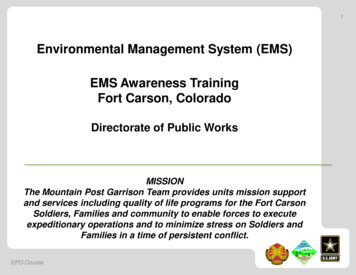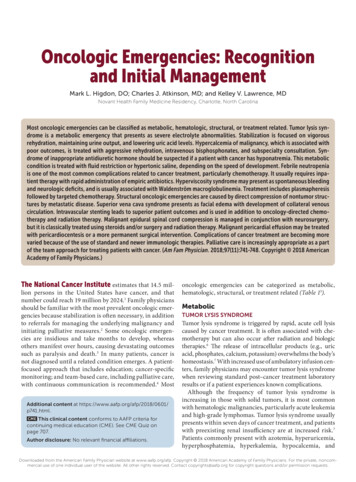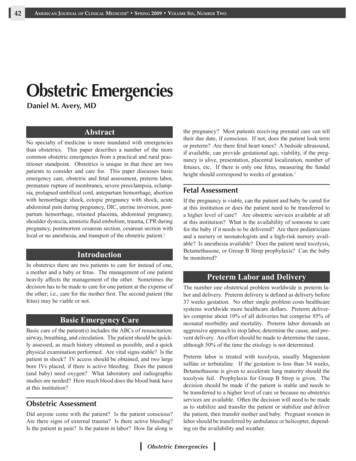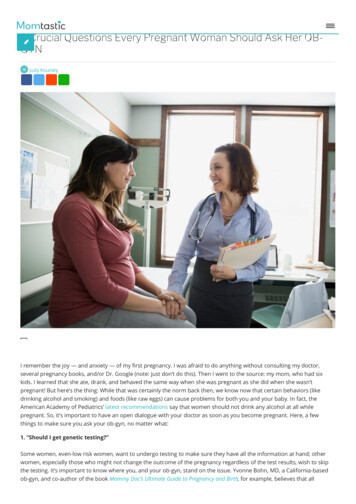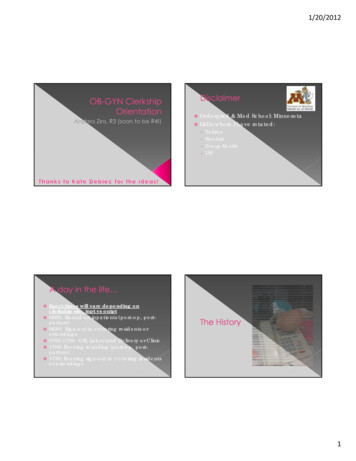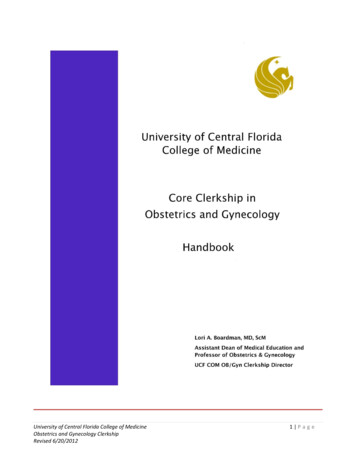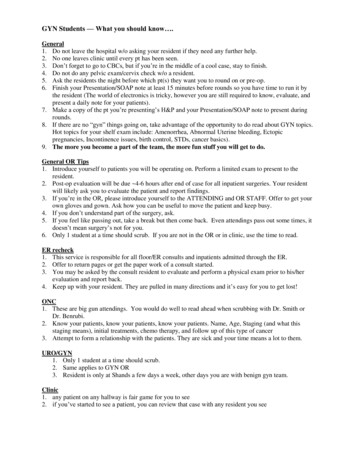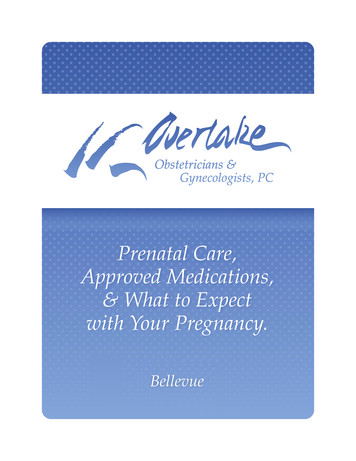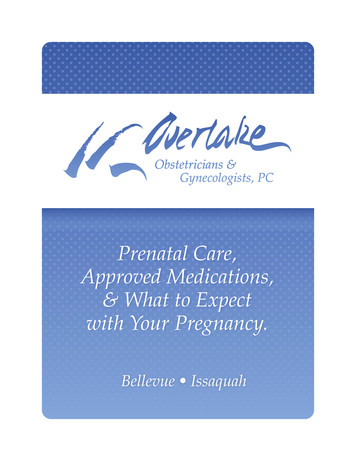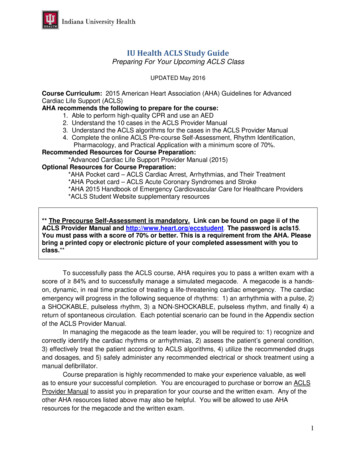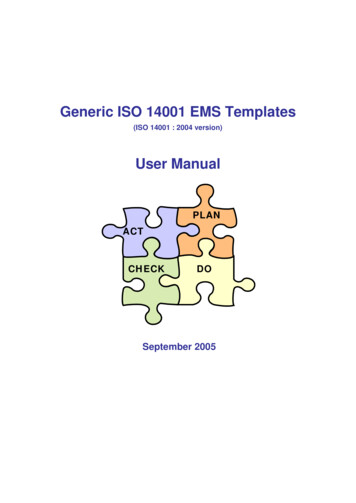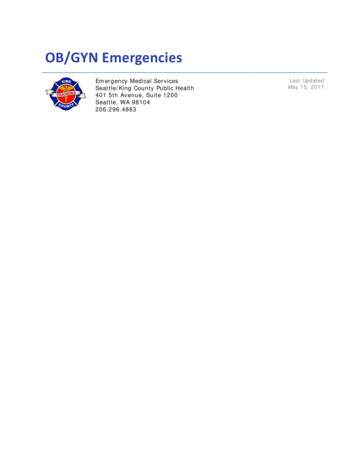
Transcription
OB/GYN EmergenciesEmergency Medical ServicesSeattle/King County Public Health401 5th Avenue, Suite 1200Seattle, WA 98104206.296.4863Last UpdatedMay 15, 2017
OB/GYN EmergenciesObstetrical EmergenciesContentsINTRODUCTION . 3ANATOMY. 3Female Reproductive System . 3Pregnancy and Fetal Development . 3PHYSIOLOGY . 4Menstrual Cycle . 5Changes During Pregnancy . 5PATIENT ASSESSMENT . 6Special Terminology . 6Prenatal Care . 7Stages of Labor. 8OB Kit . 9TREATMENT . 9Signs of Imminent Delivery . 9Preparing for Delivery . 10Assisting With a Normal Delivery . 10Care of the Mother . 11Care of the Baby - APGAR . 12Neonatal Resuscitation . 13CPR - Two-Thumb Encircling Hands Technique . 13SPECIAL CONSIDERATIONS . 13Safe Haven Law . 13Midwives and Doulas . 14 2017 Seattle/King County Emergency Medical Services2
OB/GYN EmergenciesINTRODUCTIONDealing with obstetrical emergencies can be very stressful for the EMT. Since theseemergencies are, fortunately, quite rare, most EMTs cannot rely on experience to guide theircare. A breech birth, shoulder dystocia, and eclampsia are calls that may happen once in acareer, if that. The best way to prepare for such emergencies is to be familiar with theanatomy and physiology of the female reproductive system, the progression of a normalpregnancy, and how to assist with a normal delivery. It is also critical to understand theactions that must be taken if there are complications. In addition, it is important to stay up todate on changes in issues around pregnancy, such as the Safe Haven laws that protectnewborns, and dealing with midwives and doulas in the field setting.ANATOMYFemale Reproductive SystemThe female reproductive system includes the ovaries, fallopian tube, uterus, and vagina. Theovaries are found on either side of the uterus; they serve both as an endocrine glandproducing hormones such as estrogen, and also as an organ producing eggs.The fallopian tubes stretch between the ovaries and the uterus. When an egg is released froman ovary, approximately monthly during the childbearing years, it is pulled into the fallopiantube. Fertilization from a sperm usually occurs within the fallopian tube; the fertilized eggthen makes its way to the uterus.The uterus is a powerful, muscular organ that serves as the home for the developing fetus for9 months, as well as providing the power that pushes that fetus out into the world at the endof development.The vagina extends from the uterus to the external genitalia and is the passageway that thebaby travels during childbirth.Pregnancy and Fetal DevelopmentOnce fertilized, the egg begins todivide. The fertilized egg continuesdown the fallopian tube to the uteruswhere it attaches to the endometrium.A fertilized egg develops remarkablyfast. Some of the significantdevelopment changes are highlightedbelow. 2017 Seattle/King County Emergency Medical Services3
OB/GYN EmergenciesWeeksLengthWeight(Prenatal Visits)(inches)(ounces)8 weeks 0.630.04 ounces12 weeks 2.130.49 ounces16 weeks 4.573.53 ounces20 weeks 6.4610.58 ounces24 weeks 11.811.32 pounds28 weeks 14.802.22 pounds30 weeks 15.712.91 pounds32 weeks 16.693.75 pounds34 weeks 17.724.73 pounds36 weeks 18.665.78 pounds37 weeks 19.136.30 pounds38 weeks 19.616.80 pounds39 weeks 19.967.25 pounds40 weeks 20.167.63 poundsIn addition to the changes in the fetus, otherchanges are happening in the body of themother. The placenta begins to develop in thethird week. This organ connects the mother andthe fetus. Through the placenta, the fetusreceives nutrients and oxygen, and returnswaste products to the mother for elimination;the umbilical cord serves as the connectionfrom the fetus to the placenta. The placenta isvery vascular; trauma or damage to the organcan result in life-threatening bleeding.PHYSIOLOGY 2017 Seattle/King County Emergency Medical Services4
OB/GYN EmergenciesMenstrual CycleThe menstrual cycle is a woman’s monthly hormonal cycle in which the uterus prepares toreceive an egg and then discharges a bloody fluid. The cycle repeats on an average every 28days, but can vary widely.Days 1 to 5If an egg has not been fertilized, hormone levels become lower causing the thickenedlining of the uterus to shed. This results in a woman’s period. The first day ofmenstrual bleeding is Day 1 in the menstrual cycle.Days 6 to 14During this phase, the pituitary gland produces a hormone that stimulates the ovariesto develop follicles each containing an egg. Only one egg will reach maturity and havethe potential to become fertilized. Hormone levels increase causing the lining of theuterus to thicken and prepare to receive the mature egg.Days 10 to 18The hypothalamus and pituitary glands release a hormone that causes the maturefollicle to burst and release the egg. This is called ovulation. Ovulation typically occursmidway through the menstrual cycle on Day 14.Next, the egg begins its journey down the fallopian tubes to the uterus. This is thetime period when a woman is most likely to become pregnant.Days 16 to 28After releasing the egg, the ruptured follicle takes on a new role and secretesprogesterone which continues to thicken the lining of the uterus in preparation for thefertilized egg. If the egg is fertilized by sperm, it implants in the lining of the uterus. Ifthe egg is not fertilized or does not implant, the lining of the uterus is shed again atthe beginning of the next menstrual cycle.Changes During PregnancyThere are a great many physiologic changes that occur in the mother during the 9 months ofpregnancy, as her body changes to support the growing fetus.Endocrine changes include the release of hormones associated with pregnancy. These have avariety of effects, from increasing the respiratory rate and relaxing the bronchioles, toconserving blood glucose that can be used by the fetus. Some of these hormonal changes canhave side effects, such as decreasing sensitivity to insulin, sometimes causing gestationaldiabetes.The cardiovascular effects of pregnancy are dramatic. Over the course of 9 months, thematernal blood volume increases by up to 50%. At the same time, peripheral vascular 2017 Seattle/King County Emergency Medical Services5
OB/GYN Emergenciesresistance decreases, so the overall effect is of a relatively low blood pressure. By the thirdtrimester, a normal blood pressure is 110/70; in fact a reproducible blood pressure of 140/90in the third trimester is considered pre-eclamptic and necessitates treatment. To go alongwith the increased blood volume is an increase in stroke volume and heart rate.A pregnant woman becomes hypercoagulable – in other words, her blood clots more easily. Inlikelihood, this evolved in order to help stop bleeding during pregnancy or after delivery of thebaby. However it also puts the woman at risk of pulmonary embolus. Lack of mobility duringpregnancy can increase the risk. Be alert to the possibility of embolus in a pregnant womanwho complaints of a sudden onset of shortness of breath.The gastrointestinal tract also changes with pregnancy. Early in pregnancy, women maycomplain of “morning sickness” (nausea and vomiting). It is thought that this results from thebody’s increased sensitivity to possible toxins at a time when the fetus is most susceptible todevelopmental abnormalities.The body’s musculoskeletal system must also adapt to the changes in pregnancy, includingincreased weight and a redistribution of that weight. As the woman changes her posture toadapt, she is at increased risk of falling. Also, some of the hormones of pregnancy help softensoft tissues and cartilage around certain joints, such as those of the pelvis, to ease delivery;however these changes may increase instability in walking.After delivery, it may take days, weeks, or longer for the woman’s physiology to return to thenon-pregnant state.PATIENT ASSESSMENTSpecial Terminologyabruptio placenta — This condition occurs when the placenta prematurely separates fromthe uterine wall causing heavy internal bleeding and pain; it can occur as a result of trauma.bloody show — Mucous and blood that comes from the vagina as the first stage of laborbegins. The cervix is sealed by a plug of mucus during pregnancy to prevent contamination.When the cervix dilates, the plug is expelled as pink-tinged mucous.Braxton-Hicks — Contractions that begin before labor; commonly occur in the second andthird trimester.cervix – The opening to the uterus. During the first stage of birth, the cervix opens and thinsto allow the fetus to move into the vagina. This opening process is called dilation.crowning — The bulging out of the vaginal opening caused by the baby’s head pressingagainst it.dilation — To get larger or enlarge. The degree of dilation of the cervix is often a keyindicator used by midwives and physicians to determine if birth is imminent. However, EMTs 2017 Seattle/King County Emergency Medical Services6
OB/GYN Emergenciesdo not perform this test. The process occurs over a period of several hours in some women,but can take much longer.eclampsia (toxemia) — A serious condition that can develop in the third trimester. Preeclampsia is characterized by high blood pressure, high protein in the urine, and excessiveswelling in the extremities and face. Life-threatening seizures differentiate eclampsia frompreeclampsia.ectopic pregnancy — Condition where a fertilized egg implants outside the uterus, often inthe fallopian tubes. Symptoms can include abdominal pain and vaginal bleeding.effacement — A term relating to the thinning of the cervix.endometrium – The inner lining of the uterus.meconium — A dark-green fecal material found in the intestines of full-term babies.Ordinarily, the meconium is passed after a baby is born. In some cases, the meconium isexpelled into the amniotic fluid prior to birth. It gives the fluid a greenish-brown color knownas meconium staining.placenta previa — A condition where the placenta sits low in the uterus blocking the cervix.It can present with painless, bright red bleeding.postpartum — A term used to describe the period shortly after childbirth.preeclampsia — A condition found in pregnant women characterized by high blood pressure,abnormal weight gain, edema, headache, protein in the urine, and epigastric pain. Ifuntreated, preeclampsia can progress to eclampsia.supine hypotensive syndrome — A pregnancy-related condition where the weight of anunborn fetus and the uterus puts pressure on the inferior vena cava. The result is inadequatevenous blood return to the heart, reduced cardiac output, and lowered blood pressure.Prenatal CarePrenatal care, the health care that women get when they are pregnant, has a significantpositive impact on fetal and maternal health. Early care is particularly important, since criticalfetal development takes place early in pregnancy.The number of prenatal visits is dependent on several factors, including the age of the womanand her medical history; once every 4 weeks is a timeframe used by many providers. Ifproblems with the pregnancy are discovered, the prenatal care will be adjusted accordingly.Towards the end of pregnancy, visits are recommended more frequently.The first prenatal visit is often exhaustive, including a detailed medical, vaccination, andfamily history, bloodwork, and education about smoking cessation or other lifestyle changes.At this time, women are educated to take prenatal vitamins and folic acid, which can reducethe risk of some types of birth defects. 2017 Seattle/King County Emergency Medical Services7
OB/GYN EmergenciesDuring the second trimester, the provider will often evaluate the baby’s size, heartbeat, andmovement; women at this time may be offered an ultrasound and screening for geneticanomalies.In the third trimester, visits may increase to once every 3 weeks, 2 weeks, and then once aweek. Blood pressure and urine tests may be done. There will also be screening for group Bstrep, a bacterial infection that is generally harmless in women but that can cause sepsis intheir babies. Lastly, the position of the baby in the uterus will be determined by ultrasound;based on this and other factors, the decis
15.05.2017 · OB/GYN Emergencies . Emergency Medical Services Seattle/King County Public HealthFile Size: 424KBPage Count: 14
